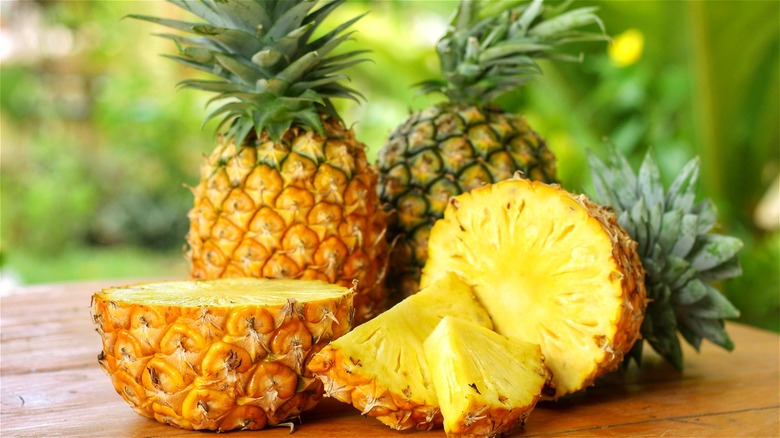The Best Two Methods For Slicing Pineapple (No Special Tools Needed)
As you peruse the produce department at your nearest grocery store, you may be tempted to add pineapple to your basket simply because the tropical fruit is so visually stimulating. However, those of us who have little time for food prep may often leave that supermarket assortment untouched because we're intimidated by that tough outer layer of skin. Beyond its textured exterior and crown of leaves, pineapples also have a pesky core that can be somewhat difficult to remove.
If you're someone who enjoys a fresh bowl of fruit salad every now and then, you may want to add pineapple to the mix, not only for its tangy sweet flavor but also for the multitude of health benefits it provides. According to the Cleveland Clinic, consuming pineapple regularly may aid your body with digestion while also giving you a host of essential B vitamins and a full day's worth of manganese.
Yet once you commit to buying this tropical fruit, you need to find the best solution for cutting and storing; a ripe pineapple will only last up to three days on your counter at room temperature. Out of all the various ways to skin and core a pineapple, the two most efficient methods both involve first cutting off the pineapple's outer layer.
Slice your next pineapple in one of two user-friendly ways
Even if you already know how to choose the right pineapple, you still have to peel and core the fruit, which can be quite an undertaking if you don't already have a foolproof method in your back pocket. The Kitchn tested six different methods of coring a pineapple and found that two stood tall against the rest in terms of simplicity, along with how much fruit or lack thereof was wasted in the coring process.
The first reliable method includes cutting around the pineapple's core after the rough outer layer has been sliced off. Simply cut off the sides of the pineapple in four big pieces, leaving a fifth centerpiece behind, which also contains the core. Then, take each quadrant, lay it flat, and slice the large strips into smaller edible chunks. While The Kitchn found this way of cutting pineapple to be quite fast, it wasn't necessarily the best method if you care about saving every last bite of fruit.
The second most effective way of preparing pineapple begins in the same way — you first cut off the outer layer. But instead of cutting around the core, you cut directly through the center, creating four large pieces once again. The core is then removed from each large piece, which immensely reduces pineapple waste. Having two reliable methods of prepping pineapple may save you time and fruit, but pineapple cores are not only destined for compost bins.
You may want to reconsider throwing away your pineapple cores
Even though the methods listed above proved to be the most reliable, there are other means of coring that still produce the same desired results. If you want rings of fruit only, for example, a coring tool may be the best option. Yet with all this talk of core removal, is the wastebasket truly the only place for pineapple cores?
Surprisingly, pineapple core is not only safe to eat but also packs a nutritional punch. Roschelle Heuberger, Ph.D., RD, a professor of nutrition at Central Michigan University, told Everyday Health in 2011 that pineapple lovers should enjoy the core raw; raw pineapple contains more nutrients than cooked pineapple does. Still, one 2012 study published in the World Journal of Emergency Surgery found that pineapple core and other high-fiber skins of certain fruits, such as persimmons and grapes, may cause phytobezoars which are hard clusters of indigested materials that can become stuck in your digestive system.
While an adequate helping or two of raw pineapple won't send your gut into a tizzy, pineapple core is tougher to chew through than standard pineapple flesh. To aid in digestibility, try boiling the pineapple's core and adding some to your favorite piña colada muffin recipe. Not only are you now armed with the best methods of coring your next pineapple, but you may also have some new uses for the tougher leftover parts, too.


